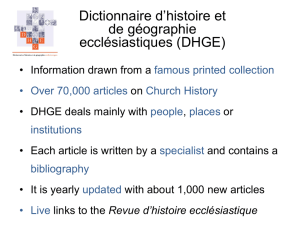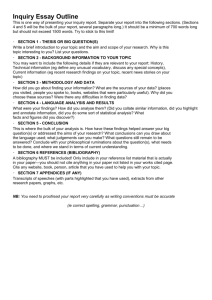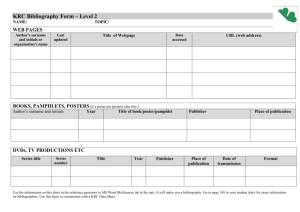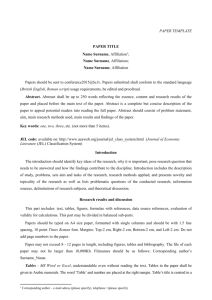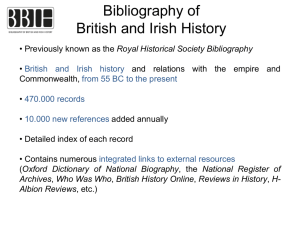Teacher notes and student sheets
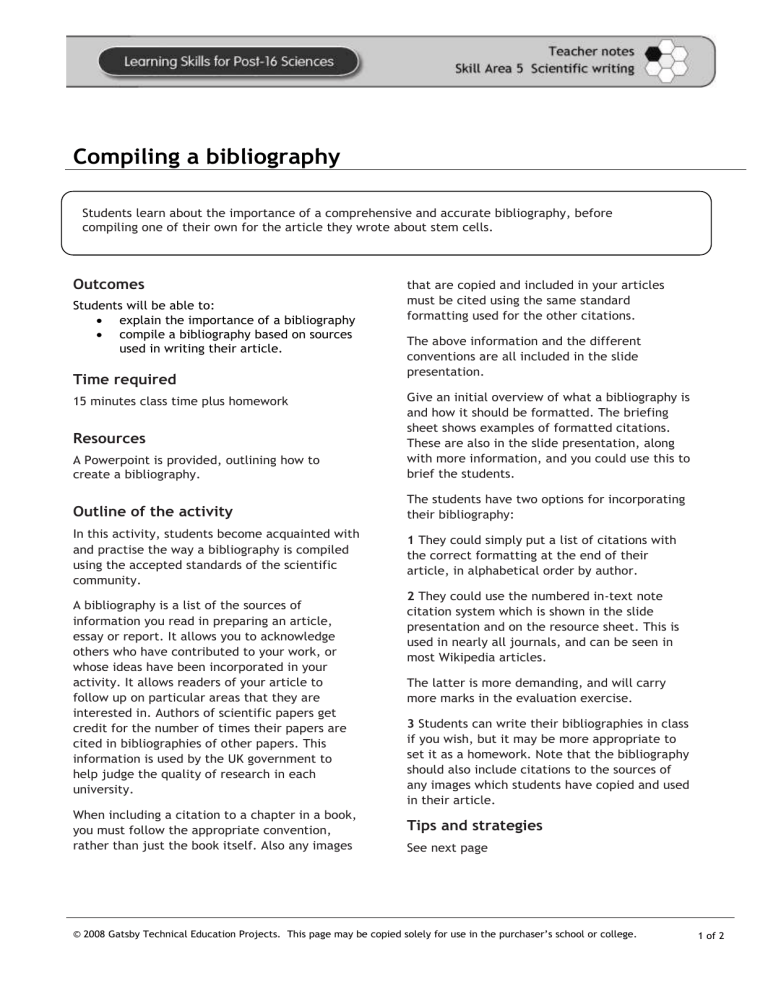
Compiling a bibliography
Students learn about the importance of a comprehensive and accurate bibliography, before compiling one of their own for the article they wrote about stem cells.
Outcomes
Students will be able to:
explain the importance of a bibliography
compile a bibliography based on sources used in writing their article.
Time required
15 minutes class time plus homework
Resources
A Powerpoint is provided, outlining how to create a bibliography.
Outline of the activity
In this activity, students become acquainted with and practise the way a bibliography is compiled using the accepted standards of the scientific community.
A bibliography is a list of the sources of information you read in preparing an article, essay or report. It allows you to acknowledge others who have contributed to your work, or whose ideas have been incorporated in your activity. It allows readers of your article to follow up on particular areas that they are interested in. Authors of scientific papers get credit for the number of times their papers are cited in bibliographies of other papers. This information is used by the UK government to help judge the quality of research in each university.
When including a citation to a chapter in a book, you must follow the appropriate convention, rather than just the book itself. Also any images that are copied and included in your articles must be cited using the same standard formatting used for the other citations.
The above information and the different conventions are all included in the slide presentation.
Give an initial overview of what a bibliography is and how it should be formatted. The briefing sheet shows examples of formatted citations.
These are also in the slide presentation, along with more information, and you could use this to brief the students.
The students have two options for incorporating their bibliography:
1 They could simply put a list of citations with the correct formatting at the end of their article, in alphabetical order by author.
2 They could use the numbered in-text note citation system which is shown in the slide presentation and on the resource sheet. This is used in nearly all journals, and can be seen in most Wikipedia articles.
The latter is more demanding, and will carry more marks in the evaluation exercise.
3 Students can write their bibliographies in class if you wish, but it may be more appropriate to set it as a homework. Note that the bibliography should also include citations to the sources of any images which students have copied and used in their article.
Tips and strategies
See next page
© 2008 Gatsby Technical Education Projects. This page may be copied solely for use in the purchaser’s school or college. 1 of 2
Compiling a bibliography
Tips and strategies
Two books which might be of interest to students (and teachers!), which also have extensive bibliographies are:
Walker, G., & King, D. (2008). The Hot
Topic. London: Bloomsbury Publishing.
Bryson, B. (2003). A Short History of Nearly
Everything. London: Transworld Publishing.
Point out to students that their bibliography will be assessed as part of the final evaluation that they will do in ‘Evaluating scientific writing’.
You may choose to make the more demanding numbered in-text note citation system compulsory, as this matches the convention of most journals.
© 2008 Gatsby Technical Education Projects. This page may be copied solely for use in the purchaser’s school or college.
2 of 2
Compiling a bibliography: briefing sheet
In this activity you will learn how to compile a bibliography.
There are international conventions for compiling bibliographies. The details can vary, but examples of standard formats are given below. Once you have studied these, create a bibliography for your article about stem cells.
Note: you must follow the conventions for punctuation and text formatting (italicised or not, etc).
For a book:
Surname of author, first name or initial. (year of publication). Title of book. City, country of publication: Publisher.
For example:
Clugston, M. and Fleming, R. (2000). Advanced Chemistry. Oxford, UK: Oxford University Press.
For a chapter of an edited book:
Surname of author, first name or initial.
(year of publication).
‘Title of article’.
In: name of editor, initial of editor. (Ed.), Title of book, page numbers. City, country of publication:
Publisher.
For example:
Daniel, J. C. Jr and Chilton, B. S. (1978). ‘Virus-like particles in embryos and the female reproductive tract.’ In: Johnson, H. (Ed.), Development of Mammals, pp 131-187. Amsterdam:
North Holland/Elsevier.
An article from a journal:
Surname of author, first name or initial.
(year of publication).
‘Title of article’.
Name of
journal, volume, page numbers.
For example:
Alder, R. W., Butts, C. P., Orpen A. G., Read, D. and Oliva J. M. (2001). ‘The chemistry of bicyclic diphosphines’, J. Chem. Soc.-Perkin Trans., 2, 282-287.
Information from the Internet:
Surname of author, first name or initial.
(year of publication).
‘Title of article.’ Name of journal
or other source as appropriate, volume (issue), page numbers. The full URL of the site, including the precise ‘page’ from which the information was taken. Last accessed <give date>.
For example:
Marcondes C.
H.
(2005).
‘From Scientific Communication To Public Knowledge: The Scientific
Article Web Published As A Knowledge Base.’ From the proceedings of the ELPUB2005
Conference on Electronic Publishing 2005, page 3. available at: http://elpub.scix.net/data/works/att/158elpub2005.content.pdf
. Last accessed 01/12/08.
© 2008 Gatsby Technical Education Projects. This page may be copied solely for use in the purchaser’s school or college.
1 of 2
Compiling a bibliography: briefing sheet
For a simple web page, use this format:
World Atlas: Maps and Geography of the World: http://geography.miningco. corn/education/geography! library/rnaps/blindex.htm
.Last accessed <give date>.
Using a numbered in-text citation system
It is common for articles to use an in-text note citation system. This uses a numbering system to identify which sources are being cited at each point in the text.
Literature cited: (This list goes at the end of the article)
1 Alder, R. W., Butts C. P., Orpen A. G., Read, D. and Oliva J. M. (2001) The chemistry of bicyclic diphosphines., J. Chem. Soc.-Perkin Trans. 2, 282-287.
2 …………
3 …………
Using in-text references
Other articles use in-text referencing, where the author’s surname and the date of the publication being cited are referred to directly in the text. As with the numbered system, the complete publication list goes at the end of the article. e.g. “It was reported that bicyclic diphosphines are the strongest trialkylphosphine bases that have been synthesised (Alder et al., 2001).”
© 2008 Gatsby Technical Education Projects. This page may be copied solely for use in the purchaser’s school or college.
2 of 2



